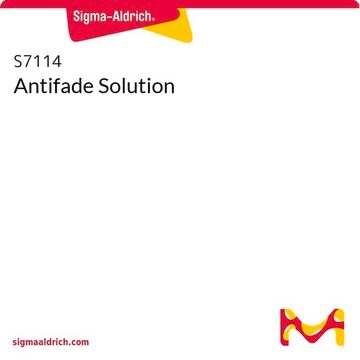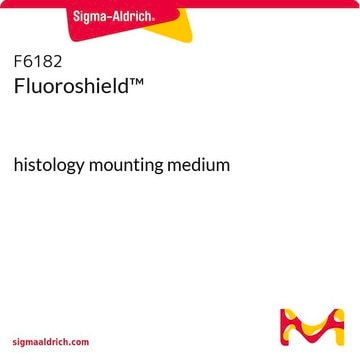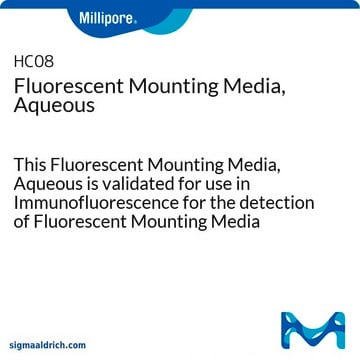MBD0015
DAPI ready made solution
For Nuclear counterstain in immunoflourecence microscopy, High Content Screening (HCS), Chromosome staining and flow cytometry (FACS)., 1 mg/mL
Sinónimos:
4′,6-Diamidino-2-phenylindole dihydrochloride, DAPI Dye, DAPI Stain, DNA Content Counterstain, 2-(4-Amidinophenyl)-6-indolecarbamidine dihydrochloride, DAPI dihydrochloride
About This Item
Productos recomendados
Nivel de calidad
formulario
liquid
condiciones de almacenamiento
protect from light
concentración
1 mg/mL
técnicas
transfection: suitable
solubilidad
water: soluble
fluorescencia
λex 340 nm; λem 488 nm (nur DAPI)
λex 364 nm; λem 454 nm (DAPI-DNA-Komplex)
idoneidad
suitable for nucleic acid staining
Condiciones de envío
dry ice
temp. de almacenamiento
−20°C
cadena SMILES
Cl.Cl.NC(=N)c1ccc(cc1)-c2cc3ccc(cc3[nH]2)C(N)=N
InChI
1S/C16H15N5.2ClH/c17-15(18)10-3-1-9(2-4-10)13-7-11-5-6-12(16(19)20)8-14(11)21-13;;/h1-8,21H,(H3,17,18)(H3,19,20);2*1H
Clave InChI
FPNZBYLXNYPRLR-UHFFFAOYSA-N
¿Está buscando productos similares? Visita Guía de comparación de productos
Categorías relacionadas
Descripción general
Aplicación
DAPI is several times more sensitive than ethidium bromide for staining DNA in agarose gels. It may be used for photofootprinting of DNA, to detect annealed probes in blotting applications by specifically visualizing the double-stranded complex, and to study the changes in DNA and analyze DNA content during apoptosis using flow cytometry. DAPI staining has also been shown to be a sensitive and specific detection method for mycoplasma.
For Nuclear counterstain in immunoflourecence microscopy, High Content Screening (HCS), Chromosome staining and flow cytometry (FACS).
Acciones bioquímicas o fisiológicas
Características y beneficios
- Ready-to-use liquid, cell permeable dye.
- Can be used with live cells and fixed cells.
- Effective for fixed-cell staining and quantitation of DNA content.
- Optimal Counterstain when using fluorescent antibodies during fluorescence microscopy or high-content screening (HCS) applications.
Forma física
Palabra de señalización
Warning
Frases de peligro
Consejos de prudencia
Clasificaciones de peligro
Skin Sens. 1
Código de clase de almacenamiento
12 - Non Combustible Liquids
Clase de riesgo para el agua (WGK)
WGK 1
Punto de inflamabilidad (°F)
Not applicable
Punto de inflamabilidad (°C)
Not applicable
Certificados de análisis (COA)
Busque Certificados de análisis (COA) introduciendo el número de lote del producto. Los números de lote se encuentran en la etiqueta del producto después de las palabras «Lot» o «Batch»
¿Ya tiene este producto?
Encuentre la documentación para los productos que ha comprado recientemente en la Biblioteca de documentos.
Los clientes también vieron
Nuestro equipo de científicos tiene experiencia en todas las áreas de investigación: Ciencias de la vida, Ciencia de los materiales, Síntesis química, Cromatografía, Analítica y muchas otras.
Póngase en contacto con el Servicio técnico












